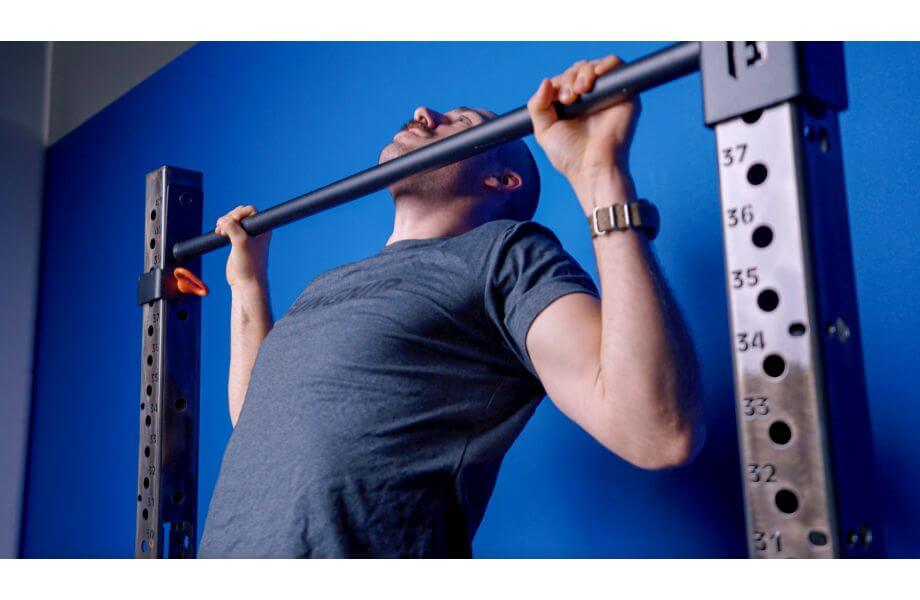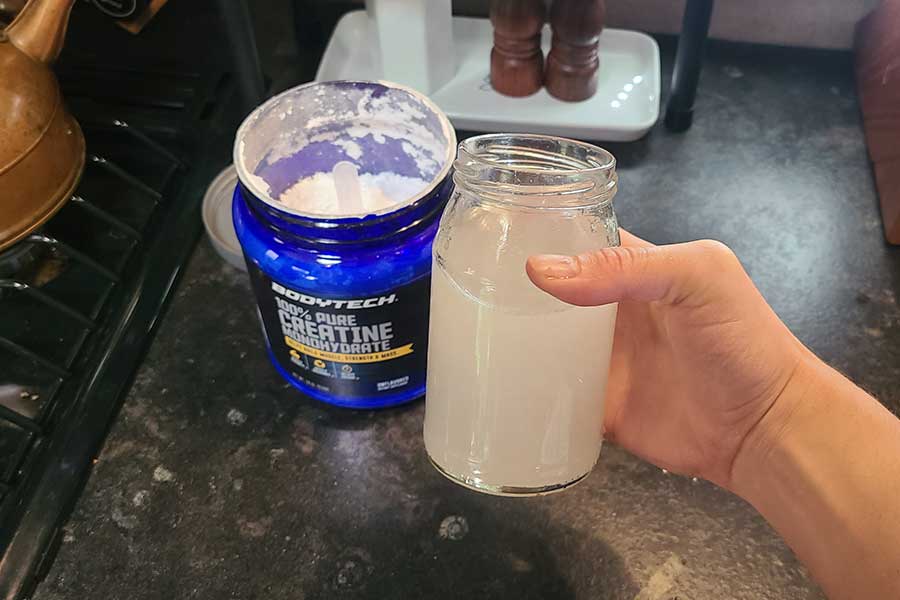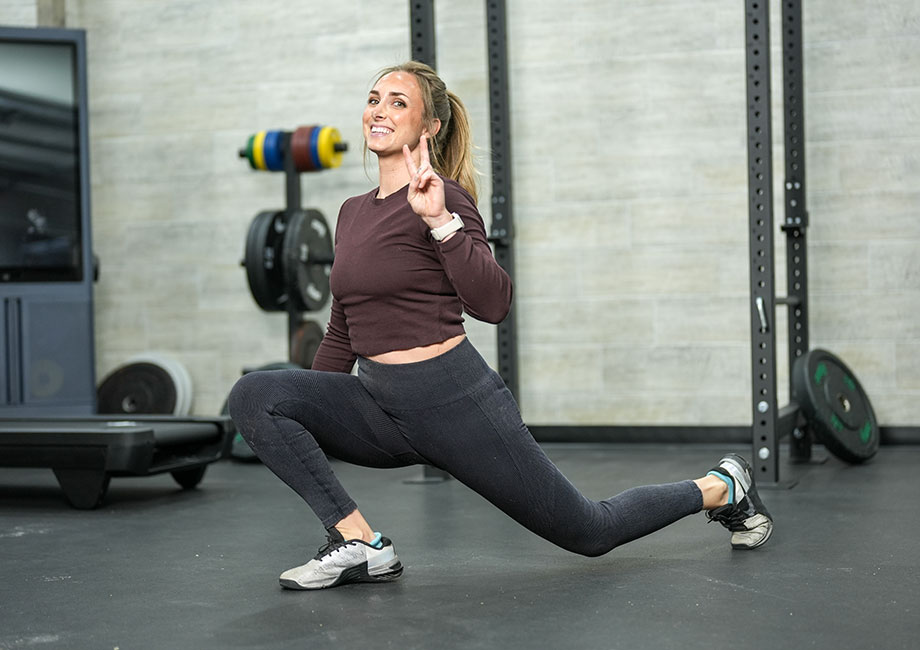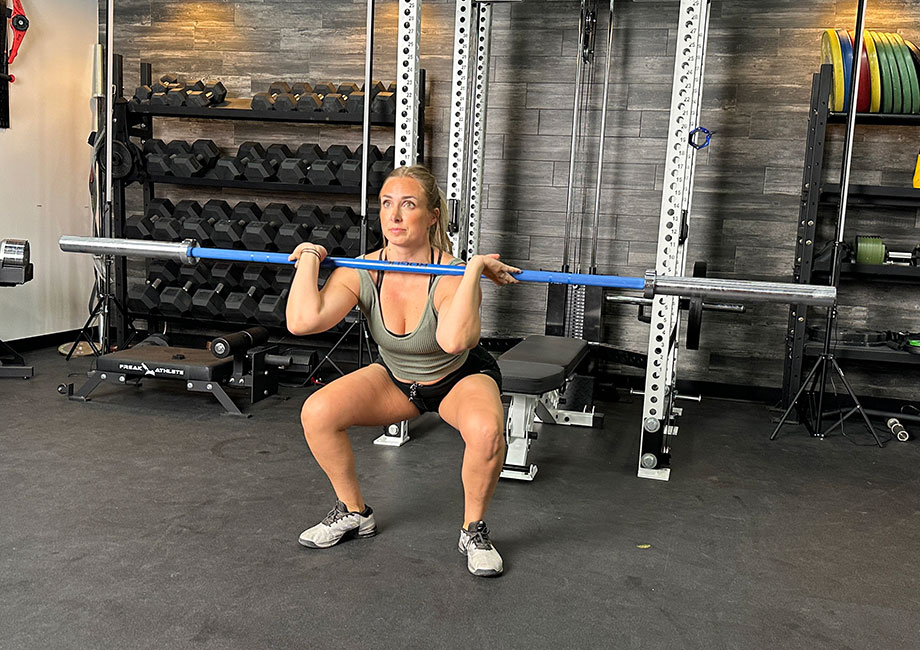Think of the bodyweight workouts you’ve done in the past. Chances are they were filled with push-ups, squats, lunges, and everyone’s favorite side dish, burpees. Lunges and squats target your quads, hamstrings, and calves. Push-ups hit your chest, shoulders, and triceps. And burpees just make you question your ”why?” for working out in the first place. As awesome as these movements are, they focus on training the front side of your body and neglect the other half: your back.
RELATED: Benefits of the Burpees Exercise and How to Do Them
Your back muscles are one of the strongest groups in the body and serve a vital role in movements like pulling (remember the rope climbs in PE class?), rotating, and stabilizing. Although you may find yourself limited in workout equipment occasionally, there’s no reason to miss out on developing a strong back. Hitting these bodyweight back exercises may help improve strength and muscle size, increase your resiliency to injury, promote shoulder health, and minimize back pain. The best part? The majority of these movements can be done with little-to-no equipment!
In the last decade of sports performance and private coaching, I’ve dealt with my fair share of athletes and clients who come to me with goals of increasing strength, wanting to move better, and relieving back pain. The secret? A strong foundation with a solid dose of the best back exercises.
What Are the Back Muscles?
Welcome to Anatomy 101. While you won’t be quizzed over one of the strongest muscle groups in your body, having knowledge will help you target the right muscles to hit your goals.
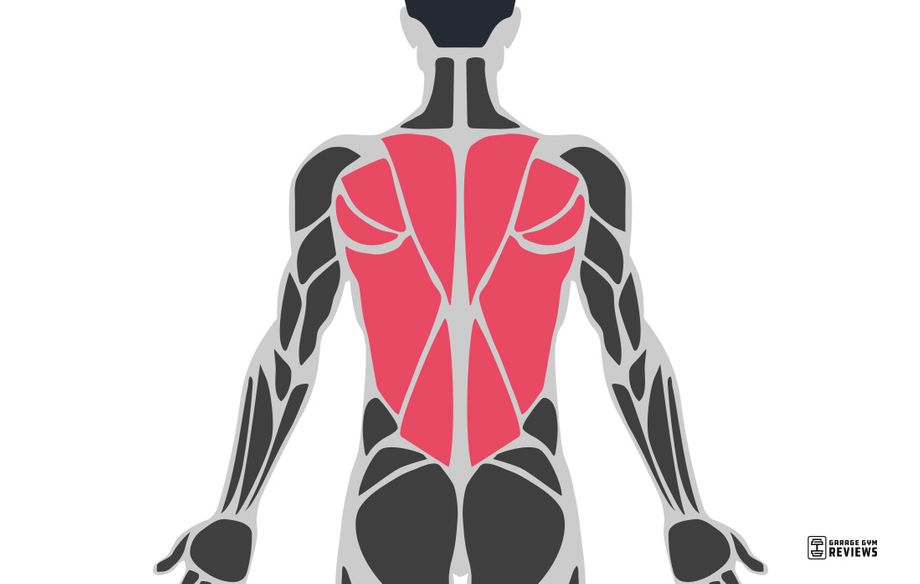
Latissimus Dorsi
The “lats” are the widest muscles in the body, originating at various points: the thoracic (upper/middle) spine, iliac crest, ribs, and scapula (shoulder blades). The lats insert between the pec major and teres major muscles on the shoulder. The main function of the lats is to internally rotate the shoulder (think of twisting your hand toward your body), adduct (bring your arm closer to the body), and extend your arm(raise your hand overhead).
Levator Scapulae
The levator scapulae originates on the first four cervical vertebrae (neck region of the spine) and inserts on the scapula (shoulder blade). It helps with the function of the shoulder blade in elevation (rising), retraction (squeezing together), and stabilization.
Rhomboid
The rhomboid originates on the top and middle spinal regions and inserts on the scapula (shoulder blade). The main function is stabilizing the spine and retracting the scapula (shoulder blade).
Trapezius
The trapezius muscle fibers originate from several points along the posterior (rear) neck and back and are inserted on the superior angle of the scapula (shoulder blade). The main function is to stabilize the scapula in place and help during actions of the shoulder and upper limbs.
Quadratus Lumborum (QL)
The quadratus lumborum (QL) originates on the iliac crest (the hip bone you often rest your hands on) and inserts on the lower back spine region. The main function is stabilizing the mid-spine and extension and bending of the torso.
Erector Spinae
The erector spinae is a group of muscles (spinalis, longissimus, and iliocostalis) that aid the spine in forward and back movement, side to side bending, and rotation.
Spinalis
This is the first muscle of the erector spinae muscle group and originates in the cervical (top), thoracic (middle), and lumbar (low back) regions of the spine and inserts in the cervical and thoracic spine. The spinalis extends the head, cervical and thoracic spine, and lateral flexion (bending) of the cervical and thoracic spine.
Longissimus
This is the second muscle of the erector spinae muscle group and originates in the cervical (top) and thoracic (middle) spine and the sacrum and inserts in the cervical spine and skull (temporal bone). The longissimus acts in extension (forward and back) and side to side bending of the spine and extension and bending of the neck.
Iliocostalis
This is the third muscle in the erector spinae group muscle group and originates on the lower ribs and sacrum and inserts on the spine (low, mid, and top regions). The iliocostalis acts in the spine’s extension and bending movements.
Multifidus
The multifidus comprises three smaller muscles: cervical, thoracic, and lumbar multifidus, which originate on the spine and insert on the side regions of the spine, a few levels above their origin points, respectively. The multifidus extends, bends, and rotates the spine.
The 9 Best Bodyweight Back Exercises
Forgetting to train the posterior chain (the muscles of the back side of the body) will leave you with posterior problems. Use these nine exercises to bulletproof your back with strength and size.
Pull-up
Primary muscles targeted: Latissimus dorsi, trapezius, rhomboids
Why we love it: Arguably one of—if not the—best bodyweight exercise of all time, the pull-up has a strong case for the top spot on your list. Not only are pull-ups an incredible option for increasing your upper-body strength, grip strength, and core stability, but training a vertical pull increases feats of strength that are more practical for daily life.
How to do it:
- Grab the pull-up bar with an overhand grip, shoulder-width apart, ensuring the arms are straight.
- Squeezing the lats, upper back, and arms, pull yourself up until your chest is at the bar.
- Lower yourself with control, keeping your lats, upper back, and arms tight until your arms are straight.
Pro tip: Using the best resistance bands is a great option to help improve pull-up strength for beginners, providing just enough assistance to execute repetitions.
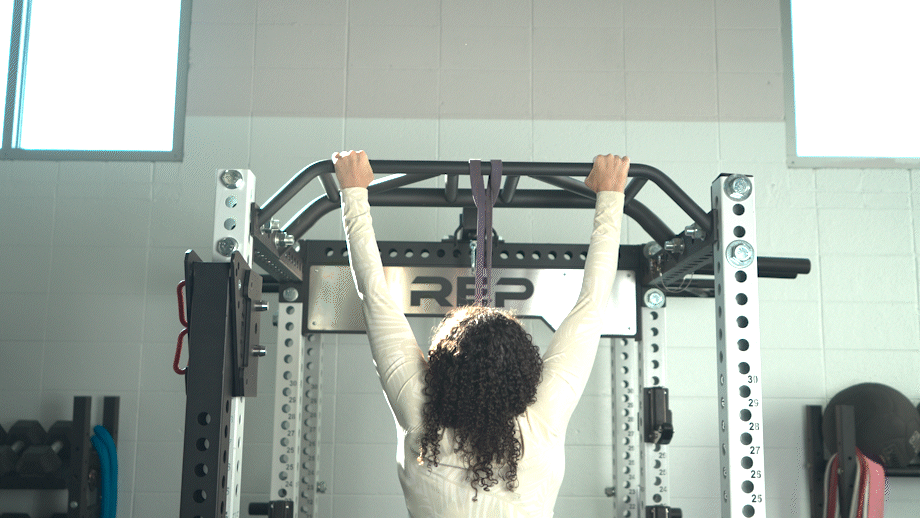
Ring Row
Primary muscles targeted: Latissimus Dorsi, rhomboids, trapezius, biceps
Why we love it: The ring row allows you to attack your back with a horizontal pull and challenge your ability to move your body weight, creating an incredible one-two punch paired with pull-ups (considered vertical pulls). If you haven’t mastered the strength for a pull-up, the ring row is your cheat code.
How to do it:
- Set the rings at hip height.
- Grab the rings with an overhand grip, shoulder-width apart, and arms straight.
- Keeping your body straight, squeeze your arms, back, and abs, and pull yourself up until your chest is even with the rings.
- With control, lower yourself back to the start position.
Pro tip: Create a stronger transition into the next rep by staying tight throughout your entire body when lowering.
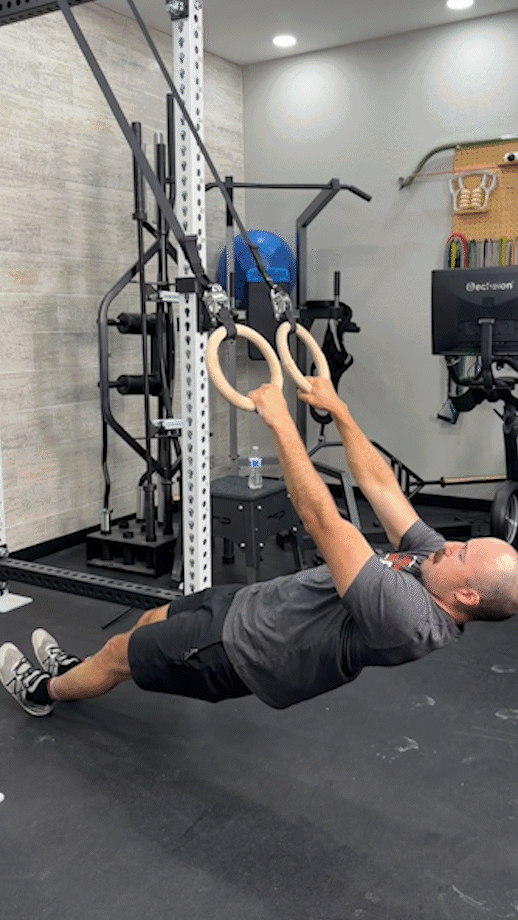
Standing Y Raise
Primary muscles targeted: Trapezius, rhomboids, levator scapulae, longissimus
Why we love it: This exercise focuses on the smaller muscles of the back and shoulders (especially those pesky rotator cuff muscles) to improve joint function and health. Add a few sets to your list of best warm-up exercises or workouts to mitigate those lingering shoulder issues.
How to do it:
- Stand with your feet hip-width apart and arms to each side, hinging at the hips, allow your chest to incline forward slightly.
- Position your hands with palms facing away from the body.
- Slowly, keep your arms straight as you reach the arms overhead, creating a “Y.”
- Squeeze the upper back muscles and hold the “Y” for one second.
- Return to the start position.
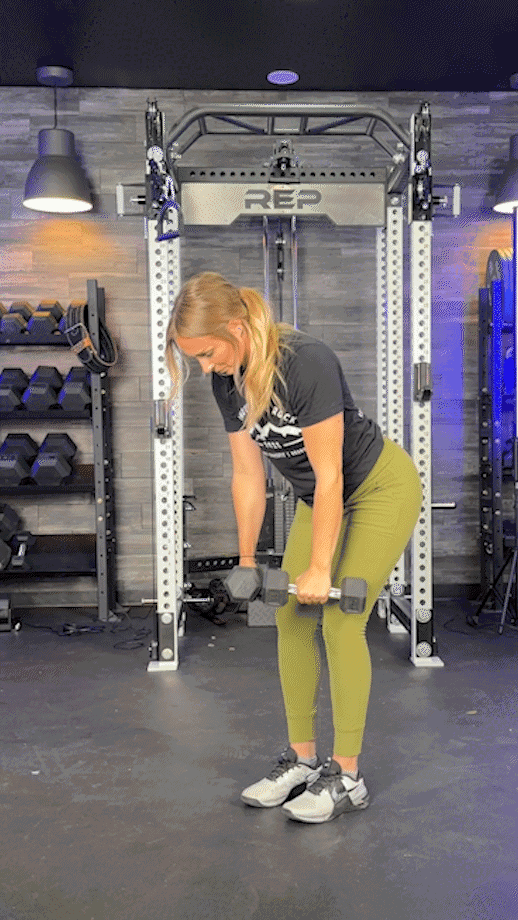
Bodyweight Reverse Fly
Primary muscles targeted: Rhomboids, trapezius, delts
Why we love it: Looking to improve your mind-muscle connection? Here’s your chance. Challenge yourself with this simple and effective movement as you focus on executing each rep, feeling a strong squeeze in your upper back and posterior (back side) deltoids.
How to do it:
- Place your feet hip-width apart, soften your knees, and hinge at your hips, allowing your torso to incline forward. Keep your back flat and let your arms hang straight down.
- Squeeze your shoulder blades to raise both arms straight back to perform the fly motion.
- Squeeze the back of your shoulders at the top of the rep and pause for one second.
- Lower your arms with control back to the start position.
RELATED: Reverse Fly Exercise
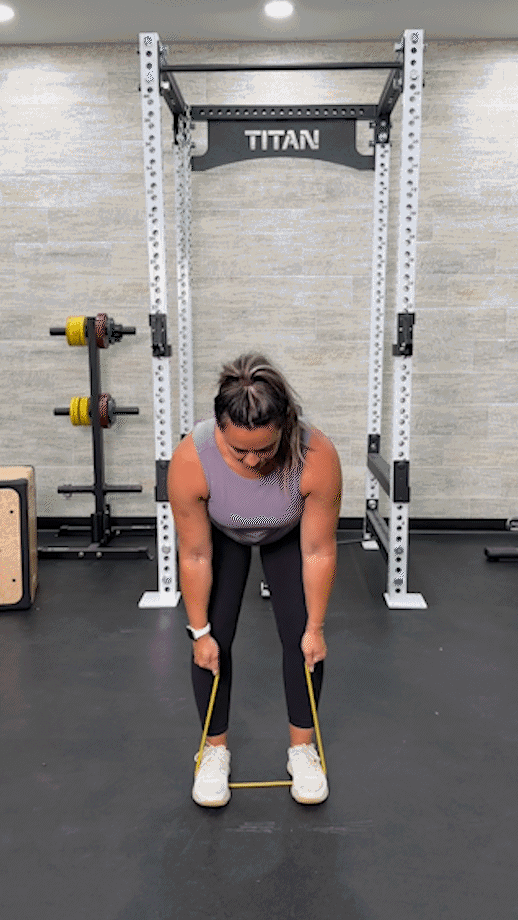
Inverted Row
Primary muscles targeted: Latissimus dorsi, rhomboids, trapezius, rear delts
Why we love it: Another challenging bodyweight back exercise to add to your movement catalog, the inverted row allows you to challenge yourself in varying positions, bridging the gap from the ring row to the pull-up.
How to do it:
- Grab a barbell (placed on a rack) or smith machine and place the bar at hip height.
- Grab the bar with an overhand grip, shoulder-width apart.
- Contract your arms, upper back, and lats, and pull yourself up to the bar until your chest touches.
- Slowly lower yourself with control, keeping your arms, upper back, and lats tight.
RELATED: Best Budget Barbells
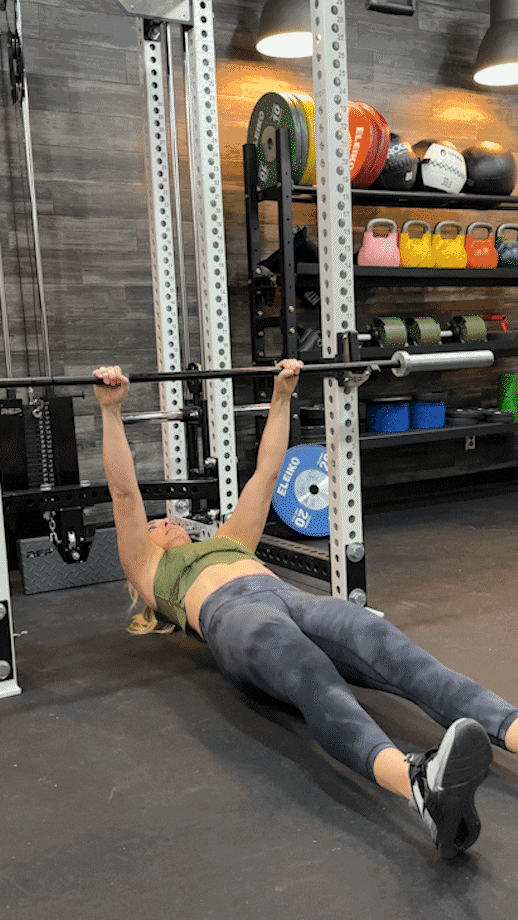
Bodyweight Good Morning
Primary muscles targeted: Hamstrings, glutes, quadratus lumborum, multifidus, erector spinae, spinalis
Why we love it: This hinging movement allows you to attack and activate the backside muscles of our lower body. Adding tempos and pauses is a surefire way to feel the connection between the hamstrings, glutes, and lower back.
How to do it:
- Stand with your feet flat, hip-width apart, and place your hands on the back of your head.
- Unlock your knees slightly and begin by hinging your hips.
- Push your hips straight back, allowing your chest to move forward until you feel a stretch in your lower back, glutes, and hamstrings.
- Pause, then bring your hips forward, squeezing your glutes and hamstrings.
- Reset your start position before each rep.
RELATED: Hamstring Exercises At Home
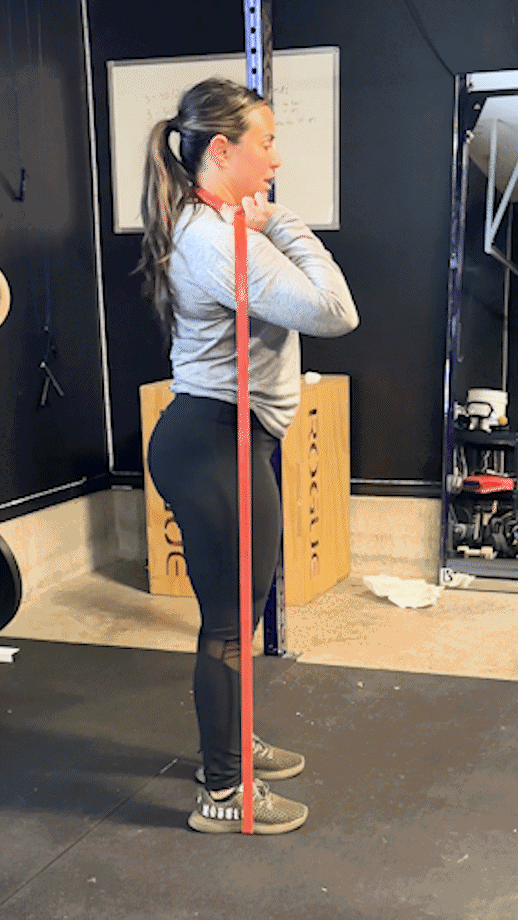
Superman
Primary muscles targeted: Hamstrings, glutes, quadratus lumborum, multifidus, erector spinae, spinalis
Why we love it: You might not be Clark Kent, but you can train the hamstrings, glutes, and low back with the superman exercise to be as strong as the Man of Steel and improve your core muscles. A consistent dose of supermans can assist with strength, stability, and decreased pain1 in the lower back.
How to do it:
- Lie facedown on the floor with your arms and legs straight.
- Squeeze your hamstrings, glutes, low back, and shoulder blades together.
- Lift your legs and arms off the floor, maintaining a strong contraction.
- Pause for one second as you hold the top of the rep
- Return to the start position.
RELATED: Lower Back Exercises
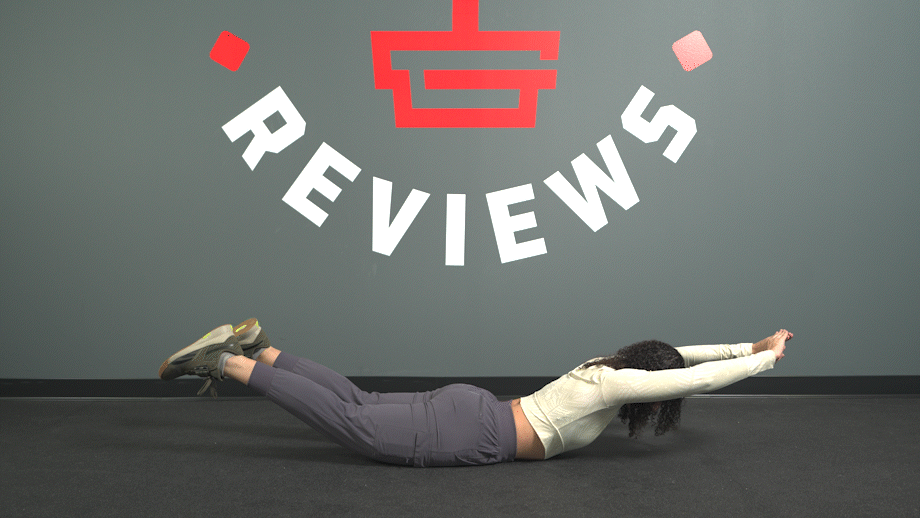
T Push-up
Primary muscles targeted: Rhomboids, trapezius
Why we love it: The T push-up gives a modern-day spin on the traditional push-up, activating the upper-back muscles and improving upper-body strength.
How to do it:
- Position yourself facedown on the floor (prone position).
- Place your hands in a push-up position, slightly under the shoulders.
- Reach your arms out to the side, creating a “T.”
- Lift your hands off the floor and squeeze the upper back muscles, holding a one-second pause at the top of the “T.”
- Squeeze the shoulder blades together, bringing the hands back under the shoulders
- Push your hands onto the floor and perform a push-up.
- Return to the start position with control.
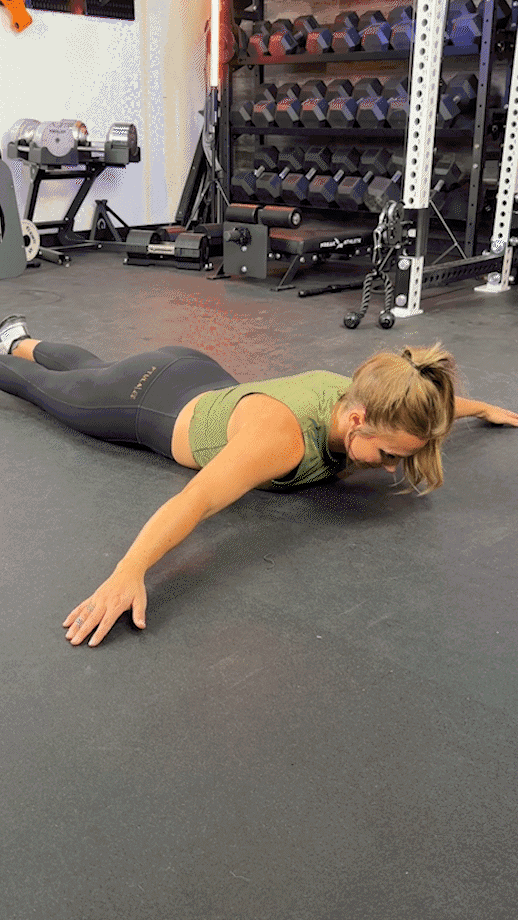
Prone Y-T-W
Primary muscles targeted: Trapezius, rhomboids, levator scapulae, longissimus
Why we love it: Movement is medicine, and this bodyweight back exercise moves you through three varying positions, improving how well your upper back functions and improving scapular (shoulder blade) strength.
How to do it:
- Position yourself facedown (prone) on the floor and extend your arms overhead in a “Y” position. Keep your thumbs pointed up.
- Squeeze your deltoids and shoulder blades as you lift your hands off the ground, holding a one-second pause at the top of the rep.
- Lower your hands to the ground and extend your arms into a “T” position.
- Squeeze the deltoids and shoulder blades as you lift the hands off the ground, holding a one-second pause at the top of the rep.
- Lower your hands to the ground and move them into a “W”, bending your elbows and placing your arms by your side.
- Squeeze the deltoids and shoulder blades as you lift your hands off the ground, holding a one-second pause at the top of the rep.
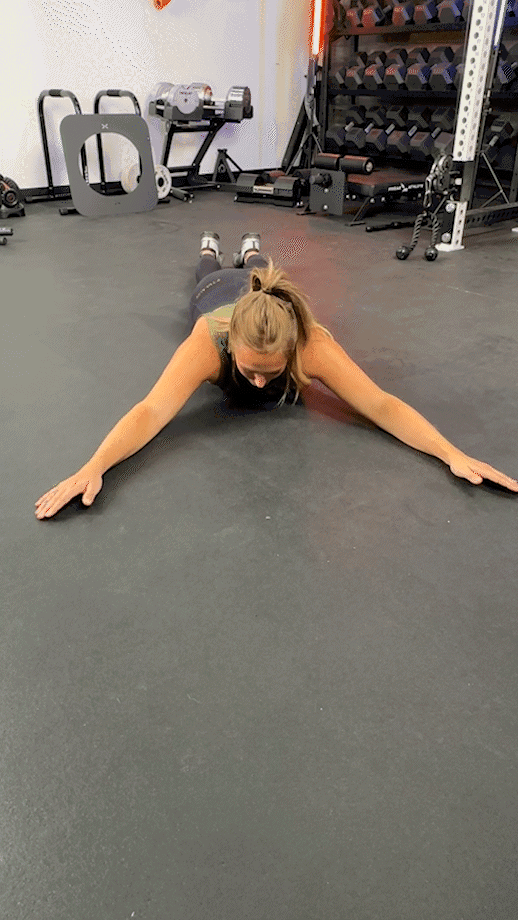
Put It Together: Bodyweight Back Workout
Give this bodyweight back workout a try next time you hit the gym or get after it at home.
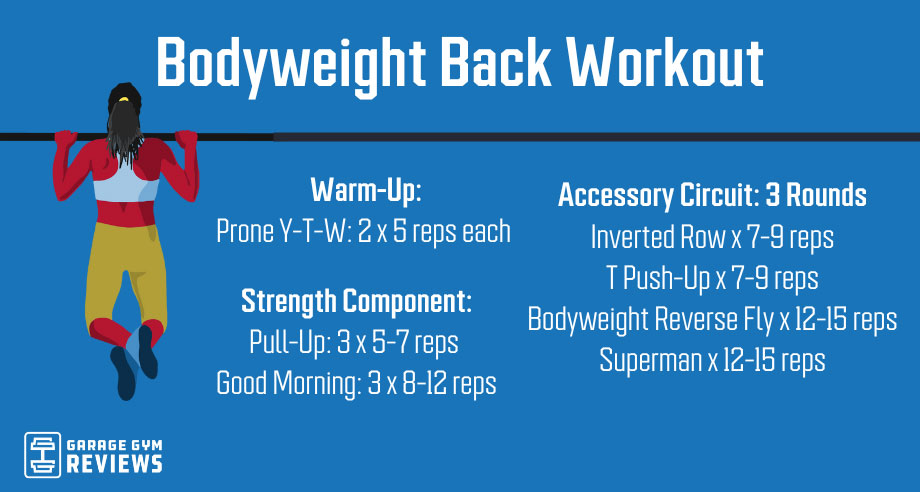
Bodyweight Back Exercises: FAQs
How can I build my back without weights?
Bodyweight movements like T push-ups, ring rows, pull-ups, supermans, good mornings, etc., may not use traditional muscle-building equipment such as barbells, dumbbells, and kettlebells. However, a 2021 study2 showed that taking advantage of tempos and isometric holds is a fantastic way of getting the most out of your bodyweight back training.
If you train your back multiple times a week, vary the direction that you are training it. Have a vertical (pull-ups and lat pulldowns) and horizontal (row variations, good mornings, movement-focused day, and don’t forget to show the smaller muscles of your back some love (prone Y-T-W’s, bodyweight reverse flys).
What is the best bodyweight exercise for your back?
The pull-up, or the chin-up if you want increased bicep recruitment3 in your back workout, is the best bodyweight back exercise one can do. Challenging your strength relative to your body weight is arguably one of the greatest markers of functional strength.
Pro tip: Perform a set to failure4 (completing as many reps in a row as possible before you no longer can complete a full rep) at the end of your sets to increase muscular endurance and size.
Are bodyweight back exercises effective?
Bodyweight training5 is very effective! Like any movement in your exercise catalog, bodyweight back exercises have their place in at-home workouts. The key is to make sure each movement makes sense. Pick an exercise for your workout because it helps you get closer to your goals, is fun and challenging, and serves a purpose.
RELATED: Program Your Own Workouts
References
- Hwang YI, Park DJ. Comparison of lumbar multifidus thickness and perceived exertion during graded superman exercises with or without an abdominal drawing-in maneuver in young adults. J Exerc Rehabil. 2018;14(4):628-632. Published 2018 Aug 24. doi:10.12965/jer.1836296.148
- Wilk M, Zajac A, Tufano JJ. The Influence of Movement Tempo During Resistance Training on Muscular Strength and Hypertrophy Responses: A Review. Sports Med. 2021;51:1629–1650. doi:10.1007/s40279-021-01465-2.
- Youdas JW, Amundson CL, Cicero KS, Hahn JJ, Harezlak DT, Hollman JH. Surface Electromyographic Activation Patterns and Elbow Joint Motion During a Pull-Up, Chin-Up, or Perfect-Pullup™ Rotational Exercise. J Strength Cond Res. 2010 Dec;24(12):3404-3414. doi:10.1519/JSC.0b013e3181f1598c.
- Willardson JM. The Application of Training to Failure in Periodized Multiple-Set Resistance Exercise Programs. J Strength Cond Res. 2007 May;21(2):628-631.
- Harrison JS. Bodyweight Training: A Return To Basics. Strength Cond J. 2010 Apr;32(2):52-55. doi:10.1519/SSC.0b013e3181d5575c.


